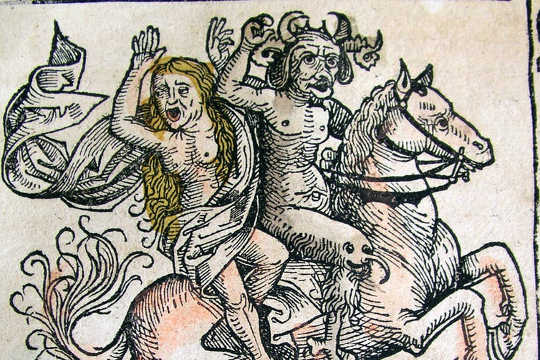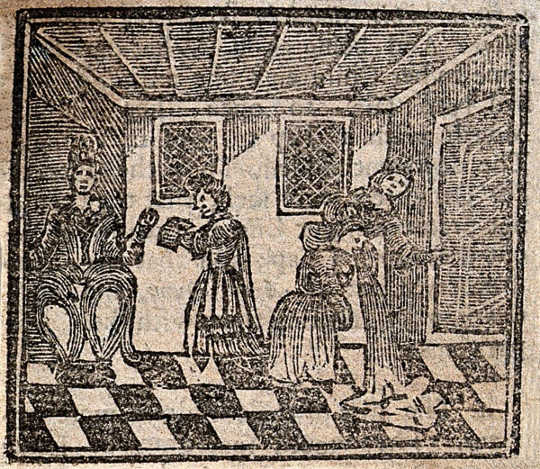 Illustrations from the Nuremberg Chronicle, by Hartmann Schedel (1440-1514)
Illustrations from the Nuremberg Chronicle, by Hartmann Schedel (1440-1514)
In the winter of 1566, 30 children in Amsterdam began to show signs of a disturbing affliction. The symptoms would strike without warning: the children would at first be seized by a violent frenzy, then fall to the ground, their bodies wracked with painful convulsions. Once the fits had passed, the children reported no memory of them.
This already looked like the work of the devil, but any lingering doubts were put to rest when the children began vomiting strange objects, like pins and shards of glass. They were experiencing, it seemed, a mass demonic possession. Multiple exorcisms would be attempted, but not before first exhausting the expertise of physicians, who often worked alongside ecclesiastical healers to mitigate the effects of such demonic assaults.
Shortly afterwards, in the nearby Duchy of Cleve, the learned physician Johann Weyer read about this mass possession, reaching him through the account of the chancellor in Gelderland. His interest was professional. Weyer himself did not believe that strange objects had actually been vomited, but he did not question that reliable authorities had witnessed this happen. Neither did he deny diabolical agency.
Instead, he reinterpreted the scope of demonic power to emphasise the devil’s longstanding status as a master trickster. The extraordinary regurgitation, he argued, was a mere illusion, a common embellishment in fact of natural illnesses often caused by the devil.
Faced with Weyer’s evaluation, modern sensibilities are left reeling. The physician’s scepticism soon appears to be countered by near incomprehensible credulity in the devil’s agency. We are compelled to ask: “But what really happened?” Many explanations have been offered for similar reports of demonic possession, often invoking categories from modern medicine or pointing to the possibility of fraud (which was considered seriously by early moderns as well).
But this gives us only a limited view of a much larger and much more complex landscape of healing in the early modern period. This was a time in which growing belief in demonic activity in the natural world genuinely shaped the understanding and experience of illness.
Recognising possession
Weyer’s account of the mass possession at Amsterdam was first published as a small part of his broader evaluation of demonic power in the 1568 edition of his book On the Illusions of Demons. There, we find many such cases that indicate the characteristic signs looked for by professionals who suspected the activity of the devil.
In addition to the physiological – such as physical pain and convulsions – more indicative psychological signs were sought, such as the demonstration of hidden knowledge, prognostication, and xenoglossy, which involved speaking in unlearned languages (especially with strange vocal alterations). Often reports of demonic possession did indeed include the expulsion of strange objects, such as, in more extreme cases, knives or live eels. Despite these extraordinary symptoms, the diagnosis of demonic afflictions was not always straightforward.
Weyer’s work tells us much about the diverse ways in which the devil was thought to operate, both in illusion and in reality – and the ways in which this complicated medicine in his time. The devil, who was often called “prince of this world”, was understood to be precisely that. Rather than wielding truly supernatural power, the devil and his demons were understood to be restricted to working in nature, which they often did in ways that escaped human understanding. These natural powers included the ability to manipulate the four humours that were believed to govern health. This meant that any natural illness, in theory, could be hiding the hand of the devil as its primary cause.
The possibility of demonic agency would not usually be considered unless natural medicines first proved ineffective, but ineffective medicine was not taken uncritically to indicate a demonic cause. Physical convulsions, for instance, were also associated with natural diseases such as epilepsy, which was already understood to be unpredictable, chronic, and potentially incurable. For physicians, demonic agency was not simply an explanation for inexplicable illnesses: it was one of many possible explanations for illnesses that might in other cases be diagnosed as purely natural.
While the activity of the devil might be a speciality of the priest, the psychosomatic symptoms associated with demonic possession also required the physician’s expertise to investigate the potential for purely natural causation.
Healing the possessed
Like today, medical diagnosis in the early modern period was fraught with difficulties. Learned physicians were rare and expensive, and in fact most healing took place in the home and among neighbours, as had long been the norm. In severe cases, rather than face the uncertainty of a learned physician – or worse, the determination that the illness was in fact incurable – most would naturally prefer the succour of the priest, who was far more accessible and often better equipped to help the unwell come to terms with their illness.
And indeed in practice, the boundaries between ecclesiastical healing and medicine were far more fluid than the terms “priest” and “physician” might suggest. These boundaries were regularly traversed in exorcism by lay healers who prescribed both natural medicines and prayer in answer to demonic afflictions.
 A bewitched woman vomiting. Woodcut, 1720. Wellcome Collection, CC BY
A bewitched woman vomiting. Woodcut, 1720. Wellcome Collection, CC BY
Weyer concluded that the most extraordinary signs of the mass possession at Amsterdam were illusory, leaving the remaining symptoms – and therefore demonic afflictions in general – much more accessible to medical intervention. For him, diabolical agency was a real factor in the subtle negotiation of diagnosis and treatment. What he understood to be the natural mechanisms of demonic activity meant that medical practitioners always had a role in addressing the symptoms of demonic afflictions.
Today, more than 400 years on, Catholic priests in America reportedly field requests for exorcisms numbering in the thousands every year. Their first recourse is to mental health professionals, belying a continuity with exorcism as it was practised in Weyer’s time. In this respect, the professionals who confront reports of demonic possession today are in agreement with their early modern predecessors: call the physician first.![]()
About The Author
Laura Sumrall, Visiting Predoctoral Fellow, Max Planck Institute for the History of Science
This article is republished from The Conversation under a Creative Commons license. Read the original article.
Related Books
at InnerSelf Market and Amazon


























